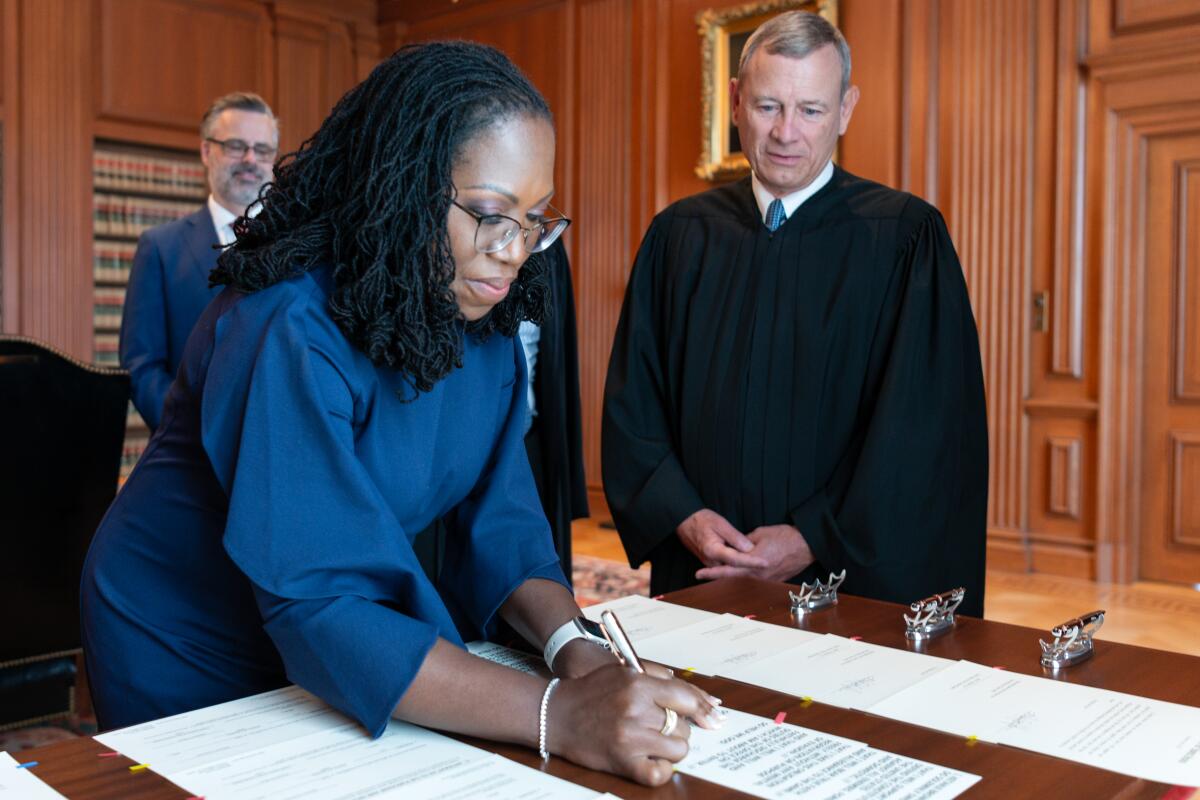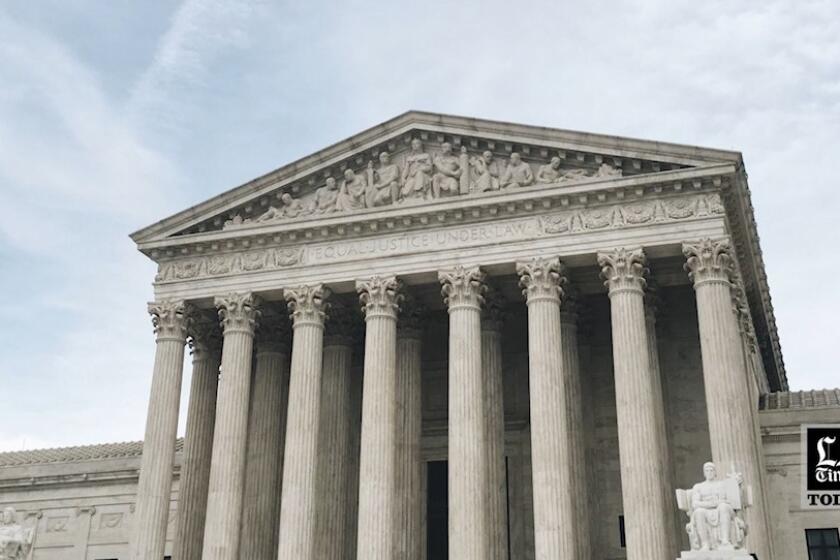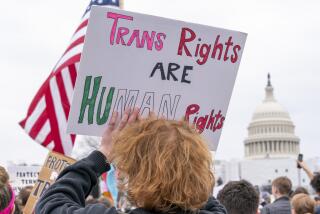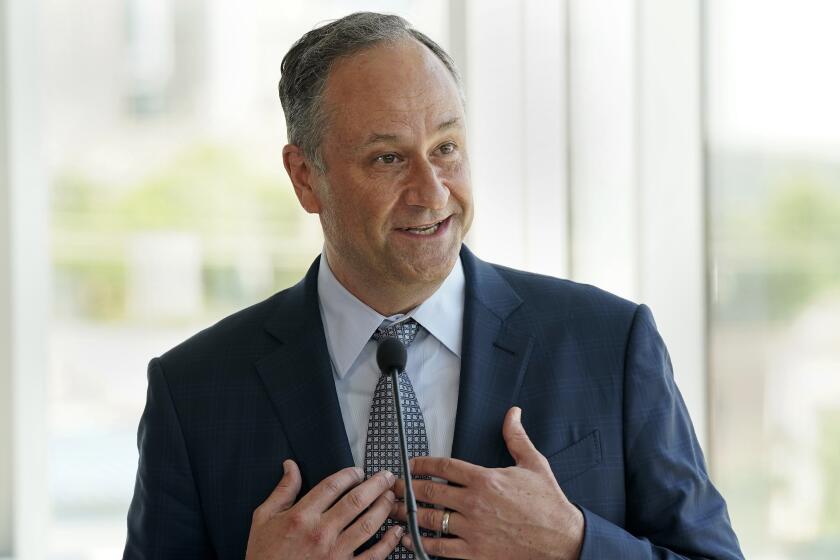Joined by first Black woman on Supreme Court, justices to tackle affirmative action, voting rights

- Share via
WASHINGTON — The Supreme Court opens a historic term Monday by welcoming its first Black woman to the bench as it faces challenges to past liberal rulings on race, affirmative action and voting rights.
At issue this year is a long-standing dispute over the role of race in the law.
Justice Ketanji Brown Jackson joins a court whose conservative majority has put itself on a collision course with progressives and civil rights advocates who insist that equal opportunity and fair representation require considering race.
“Race continues to matter,” said Deborah Archer, an NYU law professor and president of the American Civil Liberties Union. As a nation, “we continue to struggle with racial equality.”
But Chief Justice John G. Roberts Jr. has long maintained that the Constitution is “colorblind” and does not permit the use of race as a factor in deciding who is admitted to a university or how to shape an election district, even if the goal is to correct past injustices or improve diversity.
“The way to stop discrimination on the basis of race is to stop discriminating on the basis of race,” he wrote in a 2007 ruling that struck down a Seattle school diversity policy that transferred some students based on race.
The year before, he condemned efforts to draw a Latino election district in Texas as a “sordid business, this divvying us up by race.”
Court’s conservatives turn their focus to race, affirmative action and voting rights.
Roberts now has five conservatives on his right who showed they are ready and willing to make major changes in the law.
Last term, they overturned two far-reaching precedents from the 1970s: the right to abortion, set in Roe vs. Wade in 1973, and the strict separation of church and state in schools, set in Lemon vs. Kurtzman in 1971. Both rulings had been targeted by conservatives for decades.
This term, they are poised to overturn the 1978 case of University of California vs. Bakke, a 5-4 ruling that said universities may consider a student’s race as a “plus factor” to admit more Black and Latino applicants and to achieve diversity in classes.
The rulings could not only have a broad impact on higher education but could open the door to future challenges of racial diversity policies in the workforce.
In recent years, Roberts has tried — not always successfully — to forge narrow or middle-ground rulings that avoid sharp changes in the law.
He may be “leading the court this year with respect to this issue,” said Washington attorney Roman Martinez, a former clerk for Roberts. “The chief has been throughout his career focused on this idea of a colorblind Constitution as being very important to him.”
In late October, the justices will hear challenges to the affirmative action policies at Harvard, the nation’s oldest private university, and the University of North Carolina at Chapel Hill, the nation’s oldest public university.
Conservative advocates allege that both universities discriminate in favor of Black and Latino students seeking admission and discriminate against those who are Asian American or white.
The universities said they do not set quotas but consider race as one factor when choosing among highly qualified applicants. In doing so, they said, they follow the court’s precedents on diversity that began with Bakke.
Those precedents are “egregiously wrong” and must be overruled, the challengers responded, echoing Justice Samuel A. Alito Jr.’s opinion that overturned Roe vs. Wade.
As with abortion, the role of race has long divided the justices along ideological lines.
Liberals have pointed to the nation’s history of slavery, segregation and racism and said the purpose of the 1960s civil rights laws was to correct past injustices and bring about racial equality.
Conservatives quote the Civil Rights Act of 1964, which prohibits discrimination on “the basis of race” in public accommodations, employment and education. They say this provision forbids the use of race as an admission factor.
When the court first confronted the issue in the Bakke case, it decided that neither the Constitution nor the civil rights act prohibit all affirmative action by universities. A year later, in 1979, the court ruled that the Civil Rights Act did not prohibit “voluntary, race-conscious affirmative action” by employers.
That long-standing idea may face a new challenge, lawyers say, if the court rules that race-based policies at private universities violate the Civil Rights Act.
Such a ruling would likely lead to “some follow-up litigation about how much private companies can discriminate for diversity,” said Washington attorney Lisa Blatt, who argues regularly before the high court.
The court’s ruling on affirmative action should have no direct impact on the University of California because of a 1996 state ballot measure that said public agencies may not “discriminate against or grant preferential treatment” to anyone based on race or ethnicity. Since then, eight other states — including Washington, Florida, Michigan and Arizona — have adopted similar measures.
But private universities like Stanford and USC would be affected by a ruling against Harvard.
The court will hear arguments in the two cases — Students for Fair Admissions vs. Harvard and SFFA vs. University of North Carolina — on Oct. 31.
Justice Jackson will participate in the UNC case, but she stepped aside from the Harvard case because she served on the university’s Board of Overseers.
Meanwhile, in another clash over the role of race, the court will decide whether states must sometimes draw election districts where a Black or Latino candidate has a stronger chance of winning a seat in Congress, the state legislature or a local board.
Pam Karlin, a professor at Stanford Law School, said Congress adopted the Voting Rights Act to “make us a fairer and more inclusive society,” and that in turn requires taking race into account when drawing election districts.
But Alabama Atty. Gen. Steve Marshall urged the court to outlaw “race-based line drawing,” even when that is the only way to achieve equal representation for racial or ethnic minorities.
More than 27% of Alabama’s residents are Black, yet only one of its seven congressional districts, representing about 14%, has been able to elect a Black House member, due to gerrymandering.
Voting rights advocates sued the state last November and argued that its new election map for the decade ahead diluted the voting power of African Americans.
A three-judge panel that included two appointees of former President Trump agreed in January and said the Alabama Legislature could easily draw a second district in the southeast part of the state that would give a Black candidate a good chance of winning.
Alabama’s lawyers appealed to the Supreme Court. By a 5-4 vote, the high court set aside the judges’ order and allowed this year’s election to go forward under the state’s preferred map. Jackson cast her first vote in dissent.
The court’s intervention may help Republicans win control of Congress. Its decision preserved districts drawn by Republican legislatures in Louisiana and Georgia, as well as Alabama, that are almost certain to elect a white Republican rather than a Black Democrat.
After blocking a second Black majority district in Alabama, the court agreed to rule on whether the Voting Rights Act calls for considering race when states draw election districts. That case, Merrill vs. Milligan, will be argued Oct. 4.
The justices will also reconsider partisan line-drawing in a North Carolina case that has raised alarms among election law experts. At issue is whether the state legislature has an exclusive and “independent” power to set the rules for federal elections.
The case arose when the state’s Republican legislature drew a new election map that would have given the GOP control of 10 of 14 seats in the House of Representatives.
Common Cause and others sued, and the North Carolina Supreme Court ruled that the map denied voters their right to free and fair elections. A state judge then drew a new map that is expected to give Democrats a good chance of winning in at least six districts.
The high court refused to set aside the redrawn map but agreed to hear the GOP’s claim that state legislatures’ power to draw election districts — granted by the U.S. Constitution — is not subject to review by state supreme courts. The Supreme Court has not set an argument date for the case of Moore vs. Harper.
The justices could decide narrowly, perhaps by focusing only on election maps. However, election experts worry that a broad ruling in favor of state legislatures could embolden partisan lawmakers to intervene in the 2024 presidential race if their preferred candidate is losing.
Another major case this term will revisit the clash between religion and gay marriages.
California and 20 other states have broad civil rights laws that require businesses open to the public to provide full and equal service to all, including LGBTQ customers. Conservative Christians have gone to court seeking exemptions that would allow them not to participate in celebrating a same-sex marriage.
Four years ago, shortly before Justice Anthony M. Kennedy announced his retirement, the court could not agree on a constitutional ruling in the Masterpiece Cakeshop case involving a baker of wedding cakes. The court said only that the baker had been treated unfairly by a Colorado state commission.
Now the same legal team from Alliance Defending Freedom has another Colorado case posing the same issue. Lorie Smith, a graphic artist who designs websites, says she wants to expand her business to include custom websites for weddings, but not for same-sex couples. She sued, contending that she has a free-speech right to refuse to express a message that conflicts with her Christian beliefs.
She lost in the lower courts, but the justices in December will hear her case, 303 Creative vs. Elenis.
More to Read
Get the L.A. Times Politics newsletter
Deeply reported insights into legislation, politics and policy from Sacramento, Washington and beyond. In your inbox twice per week.
You may occasionally receive promotional content from the Los Angeles Times.












